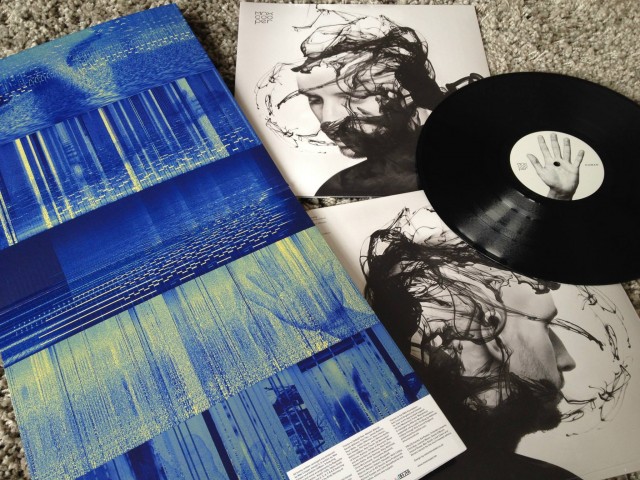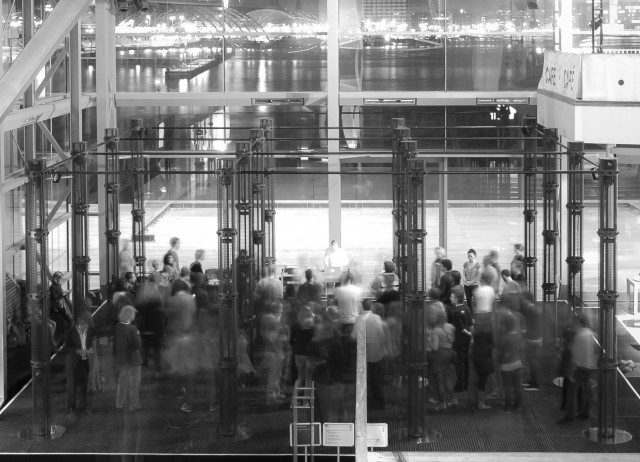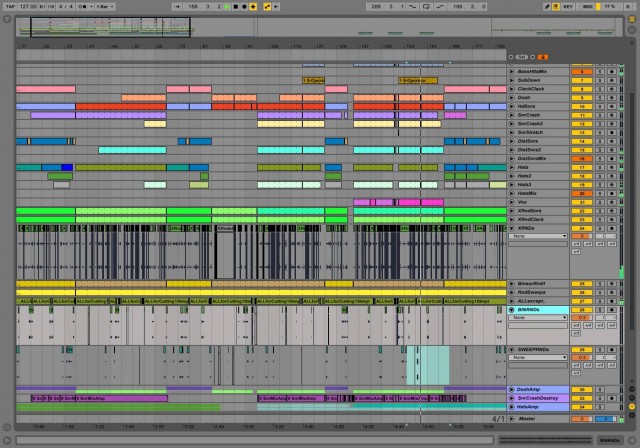Entering Max Cooper’s sonic world is always a delight. And in a new mix, we hear it pieced together as he imagines his own sonic connections, constructed live. In turns, the Belfast-born, London-based artist can be cinematic and moody, chilled-out and groovy, or angular and glitchy. But everything remains in definition, each sound there for a reason and in sharp relief, able to corner and take you anywhere, on-road or off.
It makes sense, then, that when we last caught up with Dr. Cooper – yes, he has a PhD in computational biology, too – he was adding extra dimensions to sound. That 4DSOUND project marches on from its home base in Amsterdam, piping audio through a forest of speakers. (See image below. Previously: Full Immersion in Audio, as Artists Explore 4DSOUND in a Spatial Grid [Ableton, Max, Lemur])
But in Cooper’s hands, sound has both scientific precision and easy-going, conversational fluidity, traversing any terrain. So here’s a bit of Lusine (another expert sound designer and widescreen-cinema-style electronic composer), here’s a bit of Rodriguez Jr. via the Inhuman remix package. And mostly, here’s a lot of Max Cooper being an original, weaving together his diverse musical projects.
The “live” mix was offered up mid-May by Clash – and its lovely app. The good Doctor explains:
“It’s been a long time since I’ve made a full length “live” mix of just my own material, mainly because I was focused on my album in recent times. So after some recent work developing new ideas and new experiments, I’ve got enough fresh material to draw on, along with some old, to put together a new live set only composed of my originals, some remixes I’ve done, and I had to include a couple from the Inhuman remix package because there’s some great work on there from Lusine and Rodriguez Jr. among others.”
It’s a nice survey of Human and (remix) Inhuman, out now. Tracklist:
Tracklist:
1. Max Cooper – ‘TBA1’
2. Collaboration – ‘TBA2’
3. Max Cooper – ‘Supine’ (Rodriguez Jr Remix) (Fields)
4. Microtrauma – ‘Contrast’ (Max Cooper Remix) (Traum)
5. Max Cooper – ‘Woven Ancestry’ (Lusine Remix) (Fields)
6. Max Cooper feat. Braids – ‘Automaton’ (Fields)
7. Max Cooper – ‘Automnemonic’ (Traum)
8. Max Cooper – ‘TBA3’
9. Collaboration – ‘TBA4’
10. Max Cooper – ‘TBA5’
11. Spastik Bootleg
12. Collaboration – ‘TBA6’
13. Collaboration – ‘TBA7’
Via: Fluid Landscapes: Exclusive Max Cooper Mix
Below, from top, the rather-lovely vinyl package, and what it looks like when you make your sound rig 4DSOUND instead of the usual PA.
Find Max on Facebook:
https://www.facebook.com/maxcoopermax
and SoundCloud
and the official:
http://maxcooper.net/
Max naturally collaborated with another PhD-holding friend of ours, Nicolas Bougaieff, on last year’s “Movements.” IDM doesn’t cover it. Call it techno, graduated – ambient techno and futuristic dance music engineering – speculative disco.
Here’s another wonderful mix of originals:
Postlude: I love just looking at this Ableton image – Live sets are a fascination to me as some of you know, the visual score, artifacts of the creative process. Max explained the process behind it on his Facebook page.
Yesterday we were talking about why I made a different sort of track from my usual, for the second single of the album. Today I’ll go into how I made it.
Because the track is almost atonal, there aren’t my usual synths, chords and melodies in there, just lots of different drum samples, and lots of different processing techniques.
First off, finding some interesting samples was key. I sampled clicks from old broken records, binaural samples of real world clangs and bangs, and trawled my sample databases looking for sounds and hits that might work. I even tried some demented shouting into my mic (which you can hear layered over later on in the track). Then I threw them all into drum racks, and started developing the basic rhythms and structures, and layering and editing of the samples, reverbs and filtering (often with subtle parameter variation to give subtle movement) to create the sorts of sounds I wanted. Then I arranged them all into the basic form of the track, but that was only the start really, it wasn’t finished at that point as some tracks might be.
The next step happened at Andy Ramsay’s Press Play studio in London, where we sent each drum track through real guitar amps and speakers, massively overdrove the inputs, and then recorded back the deafening cacophony. This gave me some beautiful heavily distorted sounds to play with, which I layered in at points for detail and variation, and that extra bit of nastiness when needed. Perc took these elements to the forefront in his remix, pushing the concept to the extreme (links below for both mixes for comparison).
Then came the time consuming part – lots of editing. I rendered each drum part, or sometimes drum bus, then chopped and stretched the audio, filtered, phased, panned etc etc, working on as much small detail as I could to complement the macro rhythmic structure, with the aim of making the track interesting to listen to as well as working in a club, despite it’s very stripped atonal character. I also used Max for Live devices to randomise a lot of sample parameters, rendered the randomised results and cut out and edited the audio into coherent form – rendering and editing of partially random processes is a technique I use a lot, and very useful for generating detail. Then I rendered together mixes of the already edited audio tracks, and edited the results of the mixed audio further, to give nested layers of edits. This allowed for tight audio breaks like chopping of reverb tails on the master mix, which can give a nice precise feel when needed.
I think that was pretty much it, apart from some really subtle EQing on the master before rendering off the premaster to go out to Chris McCormack at Blacklisted mastering for the EP and remixes, and Dubplates & Mastering for the album version. The reason for that was that Dubplates specifically made their masters fit into a general listening format with higher bass coverage and more mids to make everything work as best as possible on a range of systems. Whereas the single release with remixes was mastered by Chris for club systems, with more on the fundamental bass frequencies and slightly sparser coverage so as not to sound too harsh on the mids on big, very loud, systems. It’s interesting to compare the two approaches to mastering – for now only the club format is out, but the full album will be out 10th of March, with an edited down version of impacts (again, aiming for more home listening format that mixable club format).
Anyway, rant over, I hope that is of interest for some of you!
This track (Impacts) + remixes out now > http://bit.ly/Impacts



